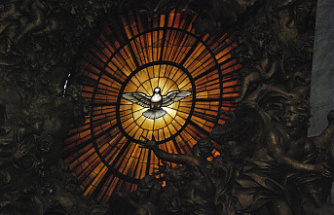At first, all is gas and dust . But that ends up collapsing in the center, forming a star. And the unused components escape and are floating around that new star. The story continues through millions of years in a process in which the particles are joining together in larger, attracted by the gravity, forming the nuclei of planets. The solar wind sweeps the lighter elements -such as the hydrogen and helium -, from neighbouring regions, leaving only the rock materials are heavier and more giving place to the worlds land, such as ours. More in the background, further away from the "influence" of the star formed the gas giants . Or, at least, this is the most accepted theory. But, what if it were not so?
Now, astronomers Spanish and German consortium CARMENES led by Juan Carlos Morales , a researcher at the Institute of Space Science (ICE, CSIC), have discovered a new world that challenges this hypothesis (known as the theory of core accretion ) which assumes that small stars correspond to small planets. The team, which published their research in the journal "Science", have discovered a world of almost half of Jupiter orbiting at an red dwarf star eight times less massive than the Sun . What can mean a whole disruption in what we believed to know so far about how to arise the planets.
"For this type of stars, models of planet formation predict that planets can form around it are small, Earth-like or similar to Neptune. However, in this system we have found that the planet GJ 3512b is a planet like Jupiter," explains Morales to ABC. In particular, it is a world about 30 million light years from Earth it takes to orbit its "small" star, 204 days . "Is located at an average distance from its star similar to the space between the Sun and Mercury, although it has a orbit very eccentric -your star is not right in the centre - and its proximity varies between 0.2 and 0.5 astronomical units," he says.
Other systems with small stars but no gas giants
A most graphic example: the star GJ 3512 is almost identical to that of proxima Centauri, and only a little more massive than the stars of Teegarden and TRAPPIST-1. All of them are home to terrestrial planets in orbits temperate and compact, but not gas giants . "It is becoming the norm to expect small planets around these small stars, so initially we thought that this great movement had to be caused by another star with a orbital period very long . We continue observing it, but with little intensity. To our surprise, the movement began to be repeated in the following season, indicating that he was actually being produced by a planet. At that time, GJ 3512 finally entered the list of top priority", explains Morales.
on the other hand, its eccentric orbit would indicate that at a given time there was another giant planet that interaccionó , and that he was expelled from the system -would now be wandering in the universe, so not alone would have formed a world unusually large, but two . "The low-mass stars should be proportionally discs are light, so that the amount of material available on the disk to form planets is reduced significantly. The presence of a gas giant around a star so small indicates that the original disk was abnormally dense or that the scenario of accretion of mass on the nucleus does not apply in this case , " said the authors. Then, how did this 'rara avis' space?
Comparison of GJ 3512 with the Solar System and other planetary systems with stars-red dwarfs - Guillem Anglada-Escude - IEEC,Theories discarded that returnThis finding "resurrect" a theory of the 90's, called " a model of instability of the disc ", it proposes that there are proto-planetary discs -which rotates the dust and gas primeval - slightly most massive and cold that can give rise to more dense regions, which produce instabilities gravitational. That is to say, areas that are not maintained by the gravitational effect of its star, the radiation, or the rotation of the disk. "This can lead to that piece of disk to collapse , and eventually forming a planet with a lot of content in gas, which size is often very large (planets, type Jupiter), quickly in a few hundred years . It is a very fast process," says the researcher of the ICE. And this system would be "the first test of the model of instability gravitational can give rise to a new population of giant planets".
this is Not the first time that it is believed to have found a planet with similar characteristics, but yes, it is new how to has been found : "The difference is that with the technique of radial velocity, which we have used now we can determine the parameters of the planet much more accurate and be confident that we stand before a giant planet ," he says.
what Other planet?The team has the certainty that the world quoted is there, but in addition houses a powerful suspicion that you would not be alone : "there is Also a signal that would correspond to a planet with an orbit of several years that we have not been able to complete," notes Morales. It would be another world tour with a much more spacious with a mass similar to "three or four" planets like Neptune . And there could be more surprises, and that other worlds smaller are orbiting around GJ 3512. "All that is only what we can know as we accumulate observations". Who knows if that place is 30 million light years, contains in its small star one of the best kept secrets of the Universe: how they build their "neighborhoods" cosmic.
Date Of Update: 27 September 2019, 10:03











